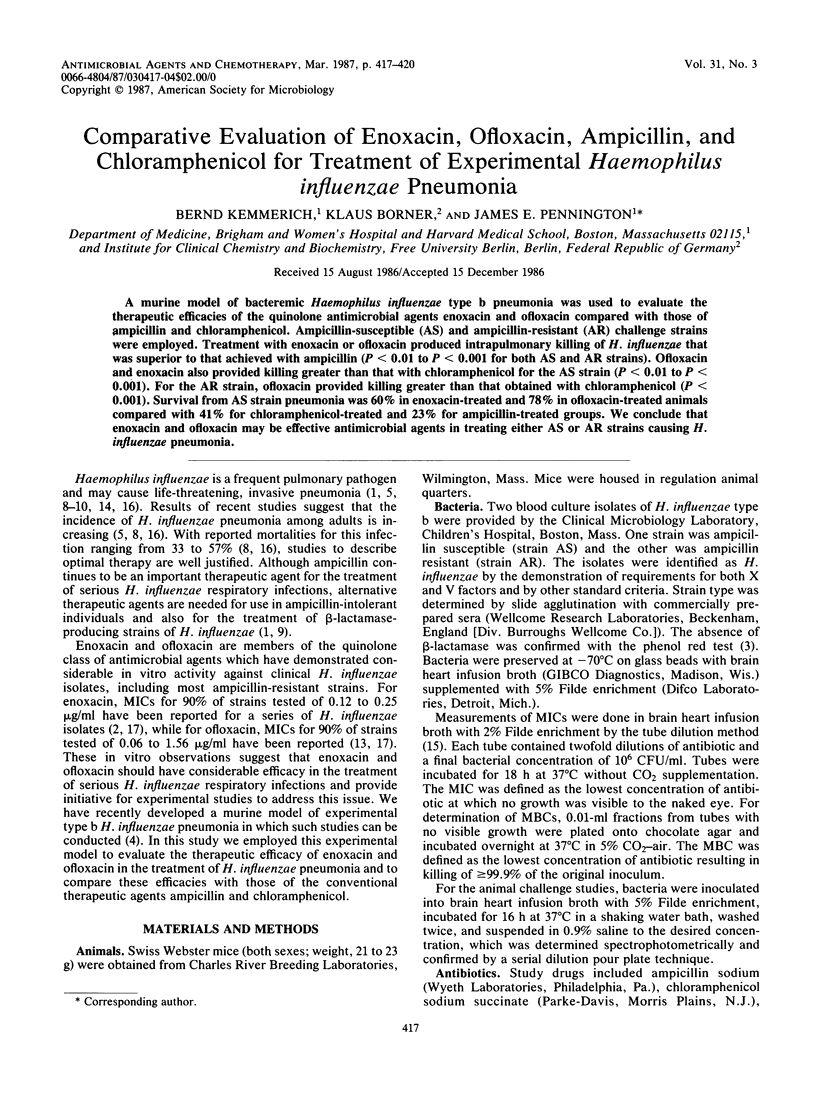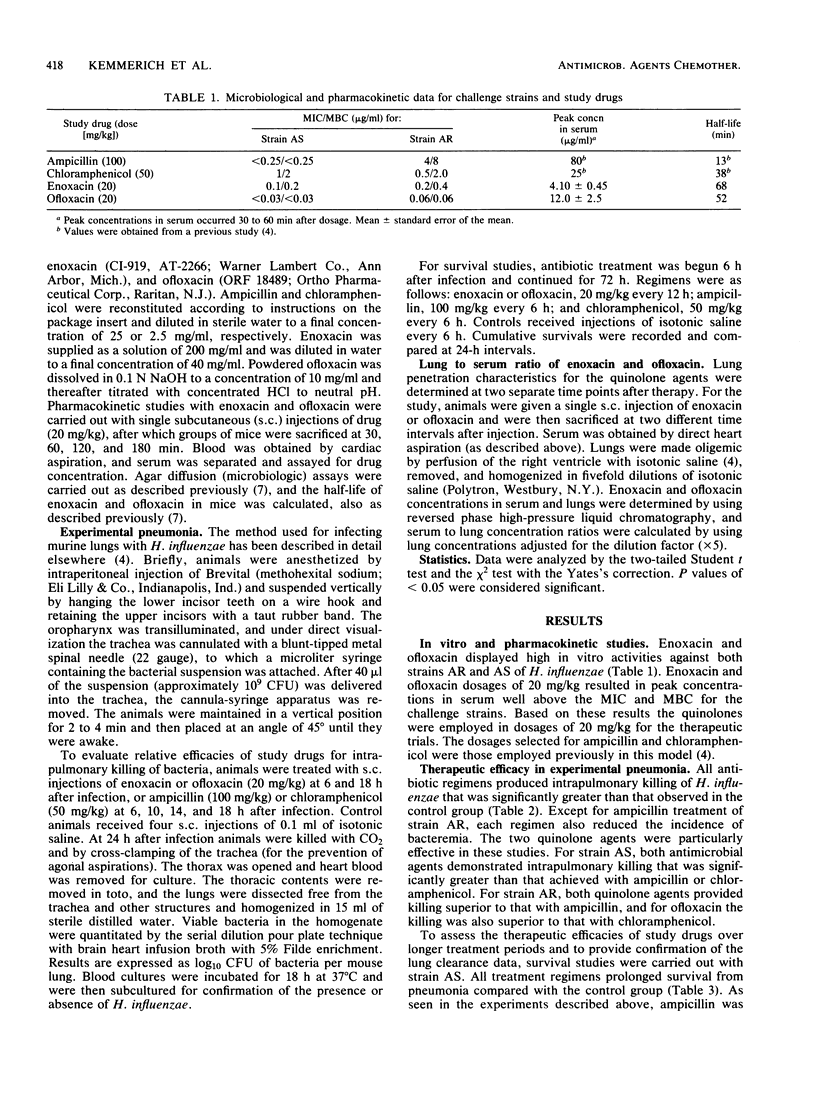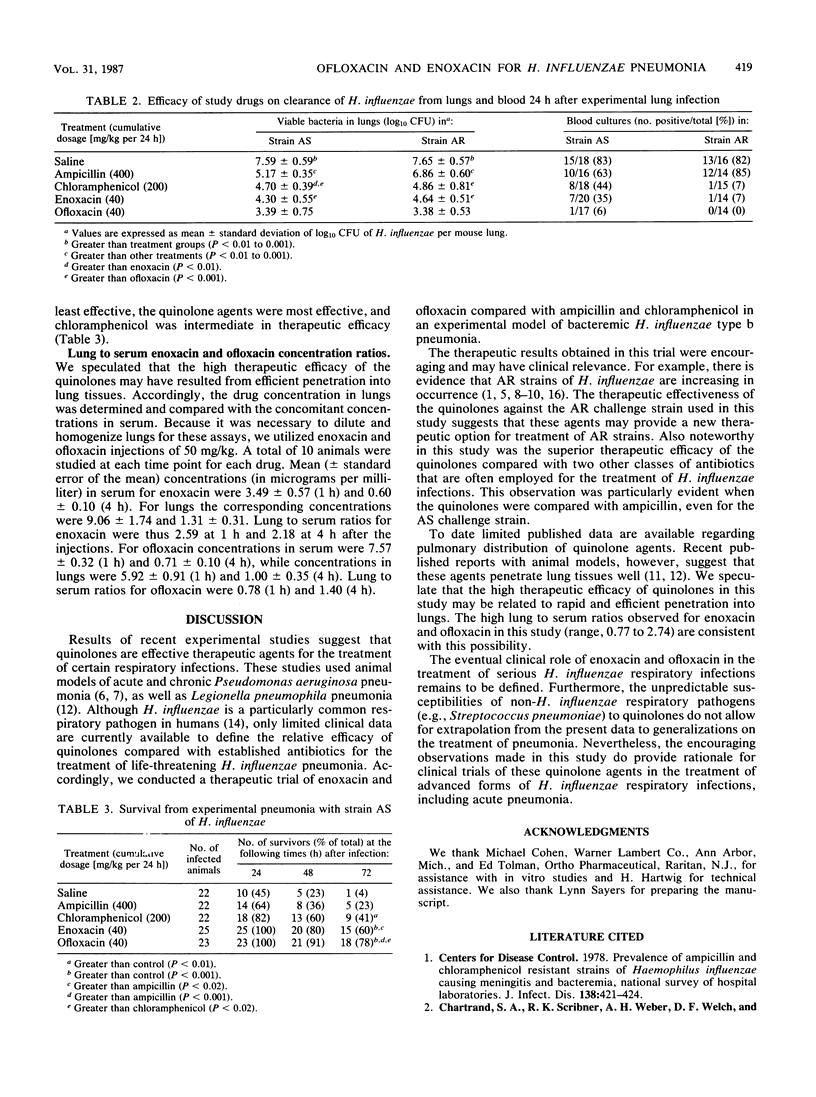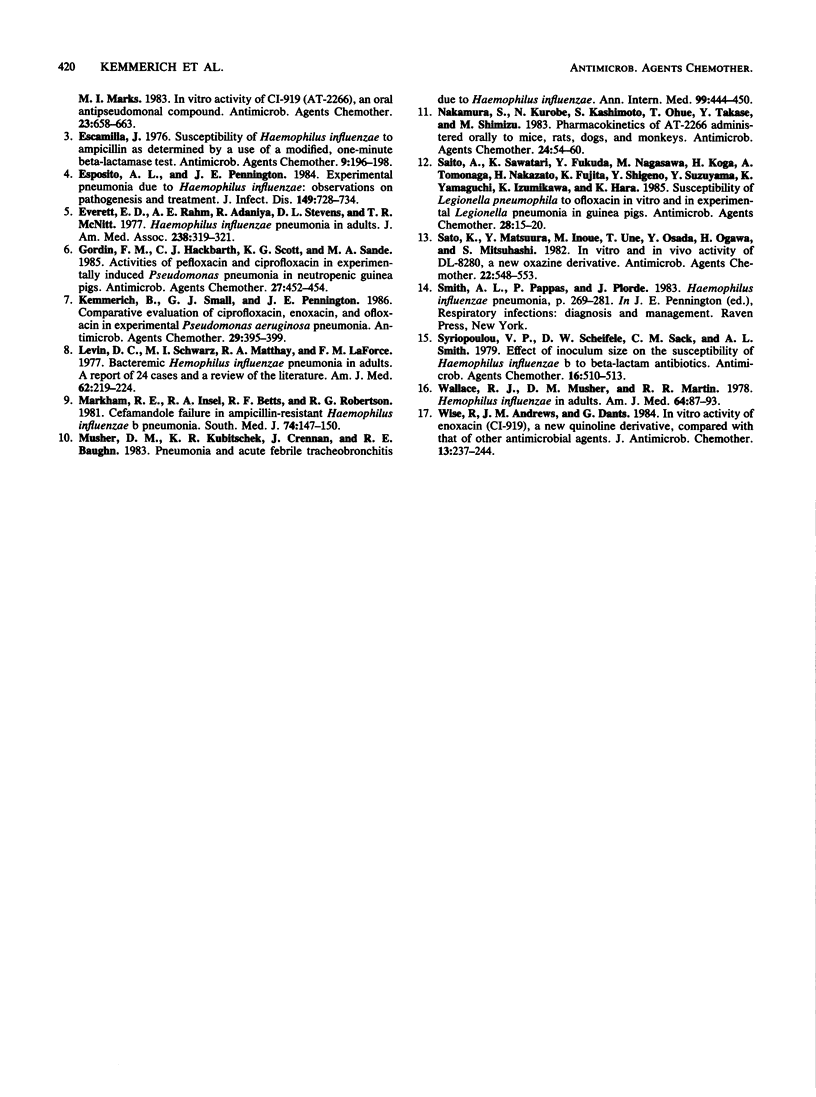Abstract
A murine model of bacteremic Haemophilus influenzae type b pneumonia was used to evaluate the therapeutic efficacies of the quinolone antimicrobial agents enoxacin and ofloxacin compared with those of ampicillin and chloramphenicol. Ampicillin-susceptible (AS) and ampicillin-resistant (AR) challenge strains were employed. Treatment with enoxacin or ofloxacin produced intrapulmonary killing of H. influenzae that was superior to that achieved with ampicillin (P less than 0.01 to P less than 0.001 for both AS and AR strains). Ofloxacin and enoxacin also provided killing greater than that with chloramphenicol for the AS strain (P less than 0.01 to P less than 0.001). For the AR strain, ofloxacin provided killing greater than that obtained with chloramphenicol (P less than 0.001). Survival from AS strain pneumonia was 60% in enoxacin-treated and 78% in ofloxacin-treated animals compared with 41% for chloramphenicol-treated and 23% for ampicillin-treated groups. We conclude that enoxacin and ofloxacin may be effective antimicrobial agents in treating either AS or AR strains causing H. influenzae pneumonia.
Full text
PDF



Selected References
These references are in PubMed. This may not be the complete list of references from this article.
- Chartrand S. A., Scribner R. K., Weber A. H., Welch D. F., Marks M. I. In vitro activity of CI-919 (AT-2266), an oral antipseudomonal compound. Antimicrob Agents Chemother. 1983 May;23(5):658–663. doi: 10.1128/aac.23.5.658. [DOI] [PMC free article] [PubMed] [Google Scholar]
- Escamilla J. Susceptibility of Haemophilus influenza to ampicillin as determined by use of a modified, one-minute beta-lactamase test. Antimicrob Agents Chemother. 1976 Jan;9(1):196–198. doi: 10.1128/aac.9.1.196. [DOI] [PMC free article] [PubMed] [Google Scholar]
- Esposito A. L., Pennington J. E. Experimental pneumonia due to Haemophilus influenzae: observations on pathogenesis and treatment. J Infect Dis. 1984 May;149(5):728–734. doi: 10.1093/infdis/149.5.728. [DOI] [PubMed] [Google Scholar]
- Everett E. D., Rham A. E., Jr, Adaniya R., Stevens D. L., McNitt T. R. Haemophilus influenzae pneumonia in adults. JAMA. 1977 Jul 25;238(4):319–321. [PubMed] [Google Scholar]
- Gordin F. M., Hackbarth C. J., Scott K. G., Sande M. A. Activities of pefloxacin and ciprofloxacin in experimentally induced Pseudomonas pneumonia in neutropenic guinea pigs. Antimicrob Agents Chemother. 1985 Apr;27(4):452–454. doi: 10.1128/aac.27.4.452. [DOI] [PMC free article] [PubMed] [Google Scholar]
- Kemmerich B., Small G. J., Pennington J. E. Comparative evaluation of ciprofloxacin, enoxacin, and ofloxacin in experimental Pseudomonas aeruginosa pneumonia. Antimicrob Agents Chemother. 1986 Mar;29(3):395–399. doi: 10.1128/aac.29.3.395. [DOI] [PMC free article] [PubMed] [Google Scholar]
- Levin D. C., Schwarz M. I., Matthay R. A., LaForce F. M. Bacteremic hemophilus influenzae pneumonia in adults. A report of 24 cases and a review of the literature. Am J Med. 1977 Feb;62(2):219–224. doi: 10.1016/0002-9343(77)90317-5. [DOI] [PubMed] [Google Scholar]
- Markham R. E., Insel R. A., Betts R. F., Robertson R. G. Cefamandole failure in ampicillin-resistant Haemophilus influenzae b pneumonia. South Med J. 1981 Feb;74(2):147–150. doi: 10.1097/00007611-198102000-00005. [DOI] [PubMed] [Google Scholar]
- Musher D. M., Kubitschek K. R., Crennan J., Baughn R. E. Pneumonia and acute febrile tracheobronchitis due to haemophilus influenzae. Ann Intern Med. 1983 Oct;99(4):444–450. doi: 10.7326/0003-4819-99-4-444. [DOI] [PubMed] [Google Scholar]
- Nakamura S., Kurobe N., Kashimoto S., Ohue T., Takase Y., Shimizu M. Pharmacokinetics of AT-2266 administered orally to mice, rats, dogs, and monkeys. Antimicrob Agents Chemother. 1983 Jul;24(1):54–60. doi: 10.1128/aac.24.1.54. [DOI] [PMC free article] [PubMed] [Google Scholar]
- Saito A., Sawatari K., Fukuda Y., Nagasawa M., Koga H., Tomonaga A., Nakazato H., Fujita K., Shigeno Y., Suzuyama Y. Susceptibility of Legionella pneumophila to ofloxacin in vitro and in experimental Legionella pneumonia in guinea pigs. Antimicrob Agents Chemother. 1985 Jul;28(1):15–20. doi: 10.1128/aac.28.1.15. [DOI] [PMC free article] [PubMed] [Google Scholar]
- Sato K., Matsuura Y., Inoue M., Une T., Osada Y., Ogawa H., Mitsuhashi S. In vitro and in vivo activity of DL-8280, a new oxazine derivative. Antimicrob Agents Chemother. 1982 Oct;22(4):548–553. doi: 10.1128/aac.22.4.548. [DOI] [PMC free article] [PubMed] [Google Scholar]
- Syriopoulou V. P., Scheifele D. W., Sack C. M., Smith A. L. Effect of inoculum size on the susceptibility of Haemophilus influenzae b to beta-lactam antibiotics. Antimicrob Agents Chemother. 1979 Oct;16(4):510–513. doi: 10.1128/aac.16.4.510. [DOI] [PMC free article] [PubMed] [Google Scholar]
- Wallace R. J., Jr, Musher D. M., Martin R. R. Hemophilus influenzae pneumonia in adults. Am J Med. 1978 Jan;64(1):87–93. doi: 10.1016/0002-9343(78)90182-1. [DOI] [PubMed] [Google Scholar]
- Wise R., Andrews J. M., Danks G. In-vitro activity of enoxacin (CL-919), a new quinoline derivative, compared with that of other antimicrobial agents. J Antimicrob Chemother. 1984 Mar;13(3):237–244. doi: 10.1093/jac/13.3.237. [DOI] [PubMed] [Google Scholar]


